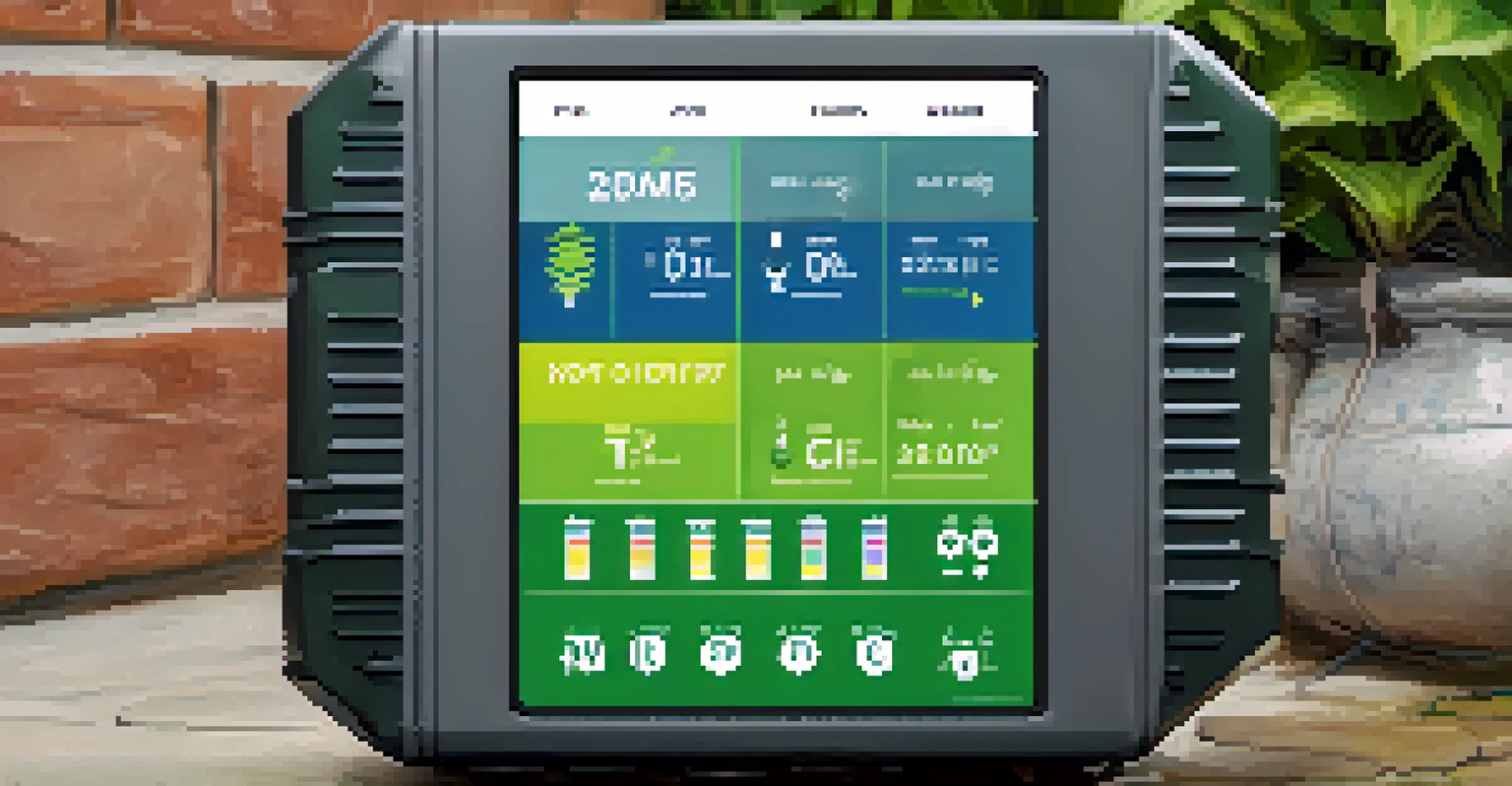Water Conservation Strategies in San Jose's Mediterranean Climate

Understanding San Jose's Mediterranean Climate and Water Needs
San Jose boasts a Mediterranean climate, characterized by hot, dry summers and mild, wet winters. This unique weather pattern significantly impacts water availability and consumption, making conservation efforts crucial. During the summer months, the region often experiences drought conditions, emphasizing the need for efficient water use strategies.
Conservation is a state of harmony between men and land.
Residents of San Jose must recognize that traditional landscaping and high water usage can strain local water supplies. Understanding this climate allows homeowners to make informed decisions about their water consumption. By focusing on conservation, the community can contribute to a sustainable future while ensuring a reliable water supply.
Moreover, awareness of seasonal changes is vital for planning irrigation and landscaping. By adapting to the climate, residents can help mitigate the effects of drought and make a positive impact on the environment. Ultimately, acknowledging San Jose's Mediterranean climate sets the stage for effective water conservation practices.
Implementing Drought-Resistant Landscaping Techniques
One of the most effective ways to conserve water in San Jose is through drought-resistant landscaping, also known as xeriscaping. This approach involves selecting plants that are native to the region, which require minimal water once established. By incorporating succulents, native grasses, and other drought-tolerant species, homeowners can create beautiful, sustainable gardens.

In addition to plant selection, employing techniques like mulching and drip irrigation can further enhance water conservation efforts. Mulching helps retain moisture in the soil, reducing the need for frequent watering. Meanwhile, drip irrigation delivers water directly to the roots, minimizing evaporation and runoff.
Embrace Drought-Resistant Plants
Switching to drought-resistant landscaping helps conserve water and supports local wildlife.
Transitioning to drought-resistant landscaping not only conserves water but also supports local wildlife. Birds, pollinators, and beneficial insects thrive in native plant gardens, creating a balanced ecosystem. This shift in gardening practices fosters a deeper connection to the environment while promoting water sustainability.
The Role of Rainwater Harvesting in Conservation
Rainwater harvesting is an innovative strategy for conserving water in San Jose. By collecting and storing rainwater from rooftops, homeowners can reduce their reliance on municipal water supplies. This practice is particularly effective during the wet winter months when rainfall is abundant.
The greatest threat to our planet is the belief that someone else will save it.
Installing a rain barrel or a more complex rainwater harvesting system can provide a sustainable water source for irrigation and other non-potable uses. By utilizing this natural resource, residents not only conserve water but also help to manage stormwater runoff, reducing the risk of flooding.
Moreover, rainwater harvesting can lead to significant cost savings on water bills. With the right setup, homeowners can substantially lower their water usage during the dry summer months. This eco-friendly approach showcases how individuals can take proactive steps toward sustainability while reaping financial benefits.
Smart Irrigation Systems: Technology for Conservation
Investing in smart irrigation systems is another powerful way to conserve water in San Jose. These systems utilize advanced technology to optimize watering schedules based on weather conditions, soil moisture, and plant needs. By automating irrigation, homeowners can ensure their gardens receive the right amount of water without waste.
Smart controllers can adjust watering times in response to rainfall or temperature changes, preventing overwatering and promoting healthier plants. This technology not only saves water but also reduces the time and effort required for manual irrigation. It's like having a personal assistant for your garden!
Utilize Rainwater Harvesting
Collecting rainwater reduces reliance on municipal supplies and helps manage stormwater runoff.
As more residents adopt smart irrigation systems, the collective impact on water conservation can be substantial. This shift towards technology-driven solutions reflects a growing awareness of the importance of sustainable practices. Embracing these innovations helps create a resilient community that values and protects its water resources.
Water-Efficient Appliances: A Simple Upgrade
Upgrading to water-efficient appliances is an easy yet effective way to conserve water at home. Dishwashers, washing machines, and toilets designed with water-saving features can significantly reduce water usage without sacrificing performance. These appliances are engineered to use less water while still getting the job done efficiently.
For instance, modern low-flow toilets use just 1.28 gallons per flush compared to older models that may use up to 3.5 gallons. By making this switch, homeowners can save thousands of gallons of water each year. This small change can make a big difference in overall water consumption.
Additionally, many utility companies offer rebates and incentives for residents who choose to upgrade to water-efficient appliances. This not only makes the transition more affordable but also encourages the community to embrace sustainable practices. Making informed choices about appliances can lead to lasting water conservation benefits.
Community Initiatives and Resources for Water Conservation
San Jose offers various community initiatives and resources aimed at promoting water conservation. Local programs often provide educational workshops, resources, and incentives for residents looking to implement sustainable practices. By engaging with these initiatives, community members can learn about effective strategies to reduce water usage.
Participating in local events, such as tree planting days or water conservation fairs, allows residents to connect with others who share similar goals. These gatherings foster a sense of community while raising awareness about the importance of water conservation. Together, residents can create a culture of sustainability within San Jose.
Upgrade to Water-Efficient Appliances
Investing in water-efficient appliances can significantly lower household water usage and bills.
Moreover, accessing resources from local government websites can provide valuable information on rebates, gardening tips, and conservation techniques. By staying informed and involved, residents can take actionable steps toward conserving water and preserving their precious resources for future generations.
The Importance of Education and Awareness in Water Conservation
Education and awareness play a crucial role in effective water conservation efforts. When residents understand the importance of conserving water, they are more likely to adopt sustainable practices in their daily lives. This collective mindset is essential for fostering a community that values and protects its water resources.
Schools and community organizations can contribute by integrating water conservation topics into their curricula and programs. Teaching children about the significance of water conservation at a young age instills lifelong habits. These future stewards of the environment will carry these lessons into adulthood, creating a ripple effect of positive change.

Through workshops, informational campaigns, and community discussions, residents can share experiences and tips on conserving water. This collaborative approach not only raises awareness but also empowers individuals to take action. By prioritizing education, San Jose can create a sustainable future where water conservation is a shared responsibility.
Conclusion: Building a Sustainable Water Future Together
Water conservation is a shared responsibility that requires the collective efforts of San Jose residents. By implementing strategies such as drought-resistant landscaping, rainwater harvesting, and upgrading to water-efficient appliances, individuals can make a significant impact. Each small change contributes to a larger goal of sustainability and protecting precious water resources.
As the community embraces technology, education, and local initiatives, a culture of conservation can flourish. The commitment to saving water not only benefits residents financially but also preserves the environment for future generations. Together, San Jose can navigate challenges related to its Mediterranean climate while fostering a thriving ecosystem.
Ultimately, the journey toward water conservation is about making informed choices and encouraging others to do the same. By working collectively, residents can ensure a sustainable water future for themselves and their community. Let's embrace these strategies and contribute to a healthier planet, one drop at a time.